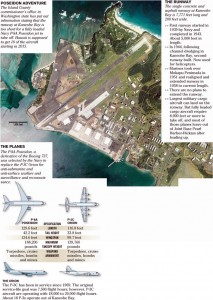As reported previously on this site, there is a campaign by elected officials and residents of Whidbey Island, Washington to keep the Navy’s new P-8A Poseidon aircraft in Puget Sound rather than relocate them to the Marine Corps Base in Kane’ohe. Below are excerpts from “Crosshairs on Kaneohe” an article in the Honolulu Star Advertiser about the competition between Whidbey and Kaneohe for the Poseidons. There are already too many negative impacts and conflicts with the local community and Native Hawaiians due to expanded Marine Corps activities in Hawai’i. We don’t want the Poseidons.
Source: http://www.staradvertiser.com/news/20110511_cross_hairs_on_kaneohe.html
William Cole writes:
A county commissioner from Washington state has mounted a campaign to secure Navy P-8A Poseidon sub-hunting aircraft for her state by claiming that Kaneohe Bay — where 18 of the jets are planned to be based — has a runway that’s too short for fully fueled and loaded Poseidons to take off.
“What can you do to help? Write a letter to your congressmen and women, state legislators and Navy brass,” Island County Commissioner Angie Homola says in her “talking points in support of the P-8A” on the Island County website.
A 2008 environmental impact statement also raises questions about the runway.
The 7,771-foot runway at Kaneohe Bay is “shorter than the suggested 8,000-foot runway for extreme operational conditions,” the Navy EIS states. “However, aircraft loads can be managed to decrease the required runway length for take off.”
The competition between Kane’ohe and Whidbey island came about when the Pentagon made cuts to its original basing plans for the Poseidons:
Hawaii, Whidbey Island in Washington state and Jacksonville, Fla., were selected as home bases for the Poseidons, a military version of the Boeing 737 that will replace aging, propeller-driven P-3C Orions.
Kaneohe Bay was picked for three squadrons and 18 aircraft that are expected to begin arriving in 2015.
But with the Pentagon seeking to cut costs, the Navy said in February it was considering operating from two bases instead of three, with Whidbey potentially being left out.
Island County said Naval Air Station Whidbey is the largest employer in the region, with a $500 million annual impact on the economy.
As part of the campaign to change the Navy’s mind, Homola said in a news release sent to newspapers that Kaneohe Bay’s “short” runway and higher costs of living “make Hawaii a costly pick,” while Whidbey offers the “optimal strategic location.”
A key tenet of Homola’s argument against Kaneohe Bay is that its runway is too short for a fully loaded P-8A, which has the fuselage of a 737-800 and wings of a 737-900.
Given the recent crash of the Sea Stallion helicopter in Kane’ohe Bay and the concern of residents when aircraft overfly the communities fringing the bay, the issue of safety piqued my interest:
The EIS said Hickam was looked at but eliminated as a possible base for Poseidons in part because ordnance handling would exceed Defense Department safety requirements.
If the ordnance handling would exceed DoD safety requirements for Hickam, why is it okay to have these aircraft in Kane’ohe? Right now the P-3C Orions operating out of Kane’ohe are being phased out due to structural problems:
All but three of the Navy’s 27 P-3C Orions at Kaneohe Bay would be replaced by Poseidons, the service said in late 2008. The number remaining at Kaneohe Bay has shrunk to about 18 with groundings due to metal fatigue and some planes out for depot maintenance, officials said.
In 2007 many of the Cold War-era sub hunters Navy-wide were grounded after studies of a test airframe and computer modeling showed there could be “significant” issues with fatigue on the rear portion of the wing.
The environmental review for the 18 Poseidons said the basing would bring an investment of $147.5 million to Kaneohe Bay for infrastructure upgrades.
These “upgrades” constitute a major expansion that would have significant impacts on cultural sites in Mokapu. There is already a decades’ old conflict over the removal of more than 2000 iwi kupuna (human remains) to make way for the runway. Native Hawaiians have been fighting the Marine Corps to have the iwi repatriated. Other construction on the base have desecrated additional burials. Despite the anticipated major impacts to cultural sites due the proposed construction, the Marine Corps has tried to restrict the required consultations under the National Historic Preservation Act (NHPA) Section 106 to only those Native Hawaiian families already involved as claimants to the burials under the Native American Graves Protection and Repatriation Act (NAGPRA), a separate statute with different criteria for having standing.
With the military base realignment plans in Okinawa, Korea and Guam meeting greater resistance both within the affected communities as well as budget-conscious officials in Washington, will Hawai’i be hit with more military expansion in the Pacific? Often these decisions follow the path of least resistance. If residents of Ko’olaupoko don’t mobilize to oppose the military expansion, there is a good chance that they will get hit with the backwash of the militarization wave in Asia.

